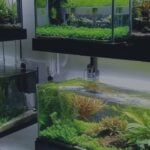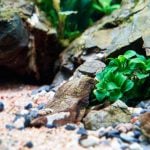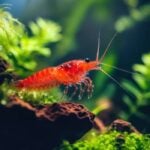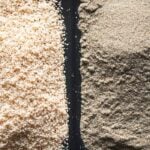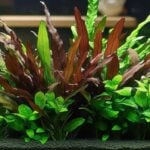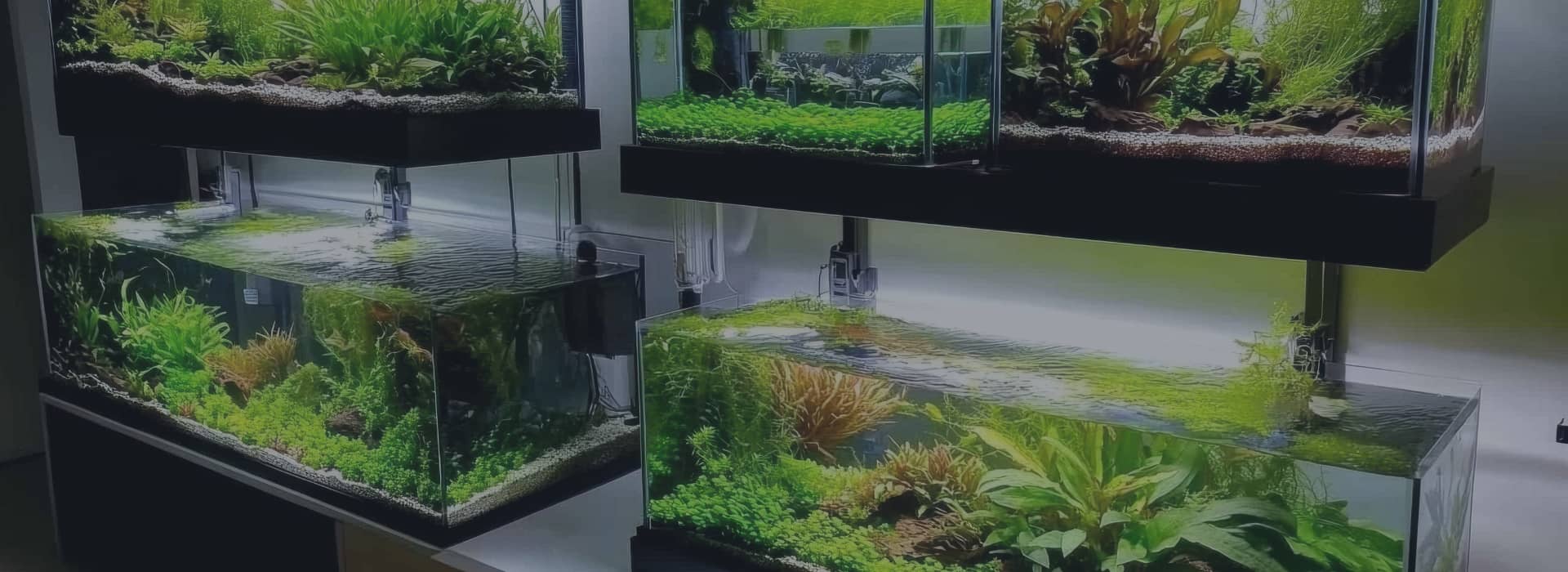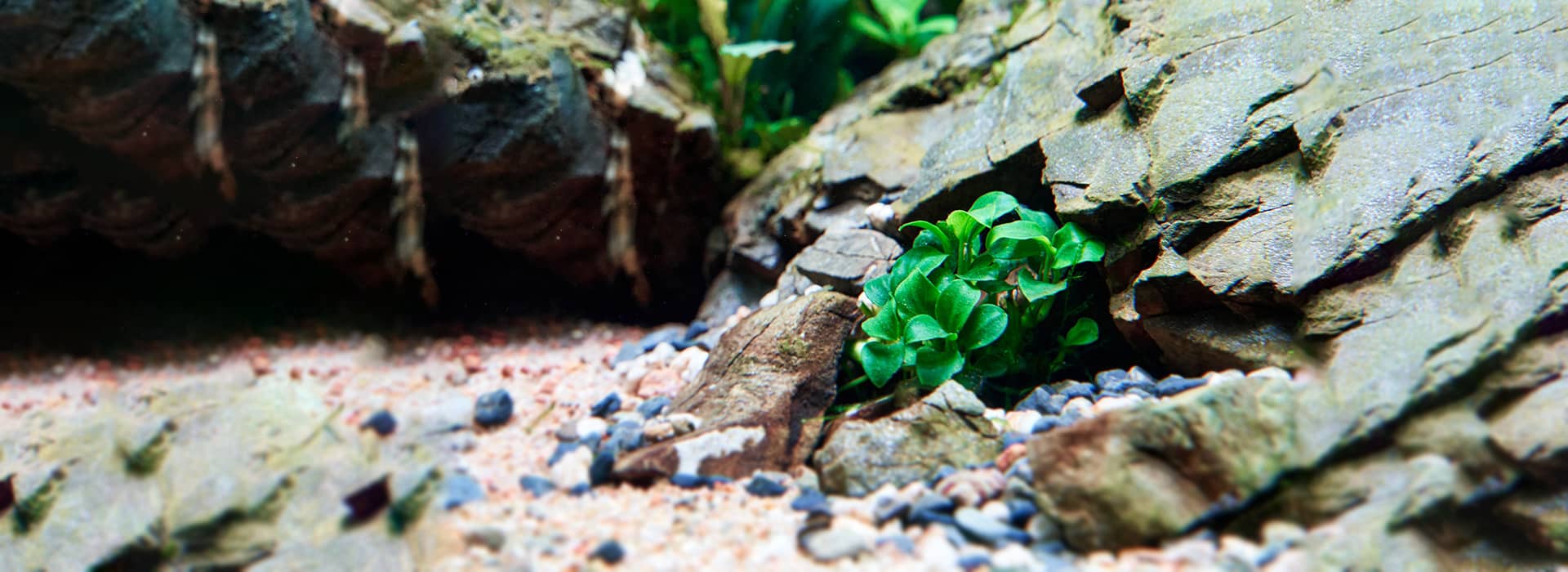Aquascaped tanks have specific requirements and choosing the right filter is crucial in ensuring the overall well-being of the setup. The best filters for planted tanks are, sponge filters, hang-on-the-back filters, canister filters, and trickle filters.
To figure out which of these will suit your tank the most, we need to take into account a few things first.
Factors To Consider When Choosing A Filter For Your Aquascaped Tank
Since there are many types of filters and multiple brands to choose from, it can get a bit confusing. It doesn’t have to be that way as long as you are properly informed, and I’ll let you in on how to go about choosing the perfect filter for your aquascaped aquarium. Here are a few key things to look out for:
- Cost
- Tank size
- Number of plants in the tank
- Maintenance
- Brand
Let us take a closer look at each of these factors.
Cost
Aquarium filters can cost anywhere from $20 to $500 or more, depending on the rate of flow, type of filter, and additional features. Here’s a rough estimate of the costs of the different filter types I mentioned previously:
- Sponge filters: $5 to $20
- Hang-on-back filters: $20 to $50
- Canister filters: $70 to $300
- Trickle filters: $50 to $500
Set a budget and choose a filter that is appropriate for the size of your tank and the specific needs of your tank inhabitants. Research and compare filters before making a purchase to ensure you get the best value for your money. The most expensive filter isn’t always the best.
Tank size
The size of the tank is another important factor. Here is a rough guideline for selecting filters based on tank size:
- Up to 10 gallons: Small hang-on-back or sponge filter
- 10 to 30 gallons: Hang-on-back filter
- 30 to 90 gallons: Canister filter
- 90 gallons and up: Combination of canister and trickle filter
Number of plants in the tank
The number of plants in the tank is the next factor to take into account. In essence, the filter should be powerful enough to process the waste produced in the tank without disturbing the plants. Here is a rough guideline for selecting filters based on this:
- Heavily planted tanks: Trickle or canister filter with low flow rate to prevent plant disturbance while providing adequate filtration and circulation.
- Moderately planted tanks: Canister or hang-on-back filter with adjustable flow rate.
- Lightly planted tanks: Hang-on-back or sponge filter with higher flow rate.
Maintenance
Different types of aquarium filters have varying levels of ease of maintenance. I have compared the maintenance level of the different filters suited for planted tanks below:
- Hang-on-back filters: Easy to maintain, require regular cleaning of the impeller and media.
- Canister filters: Moderately easy to maintain, require periodic cleaning of the media and hoses.
- Sponge filters: Easy to maintain, just need to be rinsed in aquarium water periodically.
- Trickle filters: The trickiest to maintain.
Brand
I have used multiple aquarium filter brands over the years. Here are the ones I would consider using in a planted tank along with their pros and cons.
| Brand | What’s Great | What Isn’t So Great |
| Fluval | Reliable and high-quality filters with a wide range of options | Can be expensive |
| Eheim | German-made and efficient filters with good filtration capabilities | Can be a bit complicated to maintain |
| Marina | Affordable and simple to use. Good for small aquariums | Limited options |
| Penn Plax | Wide range of products with good value for the price | May not have the same quality as some of the more expensive brands |
| SunSun | Affordable and effective. Good for medium to large aquariums | Tend to be on the noisier side |
Recommended Features In Filters For Planted Tanks
While there is nothing wrong with a basic filter as long as it can provide adequate filtration, I have found that filters equipped with the following features make life as an aquascaper a lot easier.
Adjustable flow rate: Planted tanks require a delicate balance of flow and turbulence to maintain water quality and promote plant growth. A filter with adjustable flow rate allows you to control the flow rate and customize it to your tank’s needs. This is especially useful during the initial grow-out period when a lower flow is ideal.
Low noise: One of the great things about a planted tank is how peaceful it can be. This won’t be the case if the filter is noisy. It can become very irritating very quickly especially at night. Check reviews to ensure that the filter you choose doesn’t have a noise problem.
Low maintenance: Planted tanks require regular maintenance, so a filter that is easy to clean and maintain will reduce the workload and keep things interesting instead of it feeling like a chore. A filter that requires less cleaning can free up time for other maintenance tasks as well.
Proper filtration stages: Planted tanks require mechanical and biological filtration. A stage with chemical filtration is also helpful in most cases. A filter with proper stages for each type of filtration instead of some sort of a gimmick that combines everything into one stage isn’t ideal.
Compact design: Planted tanks often have limited space, so a compact filter that takes up less space is an added bonus. However, this should not come at the cost of filtration power.
Good oxygenation: A filter that provides good aeration and oxygenation is important for planted tanks as it prevents the formation of dead zones in the tank.
Let us take a more detailed look at each of the different filters best-suited for aquascaped tanks.
Sponge filters
These are the simplest types of filters and the most affordable. An air pump is used to create suction that pulls water through a large piece of sponge. Sponge filters work in aquariums by promoting the growth of beneficial bacteria on the surface and pores of the sponge. As water flows through the sponge, these bacteria break down harmful chemicals, such as ammonia and nitrites, into less toxic compounds, such as nitrates.
Additionally, the sponge serves as a physical filter. It traps particles and debris, which helps keep the water clear. It also provides decent levels of aeration as an air pump is involved.
These filters have a lot of great features but they have their downsides as well. Air pumps are needed to get these filters to work, and they can be noisy. The large sponge that sits in the aquarium isn’t easy on the eyes either.
Pros of sponge filters:
- Affordable: Sponge filters are often one of the most affordable types of filters you can get, making them accessible to many aquarium hobbyists.
- Low maintenance: Sponge filters require minimal maintenance and can often be cleaned and reused, making them a cost-effective option over time.
- Good for small tanks: Sponge filters are commonly used in small tanks and are a great option for breeders, nursery tanks, quarantine tanks, or nano aquariums.
- Encourages biological filtration: Sponge filters are very effective at promoting the growth of beneficial bacteria.
Cons of sponge filters:
- Limited flow rate: Sponge filters typically have a lower flow rate compared to other types of filters, which can make them less effective for larger tanks or densely planted tanks.
- Poor mechanical filtration: While sponge filters are effective for biological filtration, they often provide limited mechanical filtration, meaning they do not effectively remove solid waste from the water.
- Can become clogged: Sponge filters can become clogged with debris over time, which can reduce their effectiveness drastically.
- Not as versatile: Sponge filters are best suited for specific tank types and setups and may not be the best option for all aquariums. Ideally, they are great for nursery tanks and those small, planted tanks where aesthetics isn’t a high priority.
Canister filters
Canister filters are a type of aquarium filtration system in which all the filtration takes place in a separate container. They are cylindrical in shape and are usually placed outside of the tank, connected to the tank through hoses. Canister filters use a combination of mechanical, biological, and chemical filtration methods.
Canister filters work by pumping water out through a hose. This water then passes through the various filtration media inside the canister unit. The filtered water is then pumped back into the tank, creating a continuous cycle of filtration.
Canister filters are typically more powerful and efficient than other types of aquarium filters and are suitable for use in large aquariums or those with many plants, fish, and/or invertebrates. Canister filters are among the most customizable filters you can get as a wide range of filter media can be used with ease.
Pros of Canister Filters
- High Efficiency: Canister filters are known for their high level of filtration efficiency. They can be used in aquariums in which a lot of water has to be filtered quickly and efficiently.
- Versatility: Canister filters can be customized with a variety of filtration media to meet the specific needs of the aquarium and its inhabitants.
- Large Capacity: Canister filters have a large capacity for filtration media, allowing for longer periods between maintenance and cleaning.
- Quiet Operation: Canister filters are known for their quiet operation, making them ideal for use in aquariums located in living spaces.
Cons of Canister Filters:
- Size and Visibility: Canister filters are larger and more visible than other types of aquarium filters, which may be an issue for hobbyists who want to maintain a clean and streamlined aquarium environment. A cabinet or some sort of storage space is needed to keep the somewhat bulky canister out of sight.
- Cost: Canister filters are typically more expensive than other types of aquarium filters, which may be a factor for hobbyists who are working within a limited budget.
- Complexity: Canister filters can be quite complicated to install and service than other types of aquarium filters. This can be problematic for hobbyists who prefer a more straightforward experience. The hoses have to be connected securely as a loose connection can result in all the water in the tank ending up on your floor. Trust me, you do not want to experience the aftermath of such a mishap.
- Maintenance: Canister filter maintenance is also complicated. Replacing the filter media and ensuring that all the connections are watertight after the maintenance is complete requires extra care. This is time-consuming and potentially messy even if there is a small error.
Hang-on-back (HOB) Filters
Hang-on-back (HOB) filters are, as the name suggests, designed to hang off the back of the aquarium. They are one of the most popular types of aquarium filters due to their simplicity, ease of use, and affordability.
HOB filters work by drawing water from the aquarium into the filter, where it is passed through a sponge or other type of mechanical filter media to remove waste and debris. The filtered water is then returned to the aquarium. Some HOB filters also incorporate biological filtration media, such as ceramic noodles or bio-balls, to promote the growth of beneficial bacteria that help to break down waste and maintain water quality.
Pros of HOB Filters:
- Affordable: HOB filters are typically less expensive than other types of aquarium filters. They offer the most bang for the buck among the budget-friendly options.
- Easy to Install: HOB filters are relatively simple to install. Often times, it is as simple as hanging the filter in the back and connecting it to a power outlet. There are no complication fittings or connections to worry about.
- Customizable: HOB filters can be customized with different types of filter media to suit the specific needs of the aquarium, such as either a focus on removing impurities or a higher focus on promoting biological filtration.
- Efficient: HOB filters are efficient at removing waste and maintaining water quality, making them ideal for use in small to medium-sized aquariums. They are also quite power efficient.
Cons of HOB Filters:
- Limited Filtration Capacity: HOB filters have a limited capacity for filter media, which means that they may need to be cleaned and replaced more frequently than in other types of filters.
- Not Suited For Larger Tanks: HOB filters are less powerful than other types of filters, such as canister filters. In larger tanks or tanks with a lot of biomass, you will need other forms of filtration.
- Noise: HOB filters can be noisy, which may be an issue for hobbyists who have aquariums located in living spaces.
- Maintenance: As mentioned earlier, HOB filters need to be cleaned more frequently than other types of filters. Accessing them can also be difficult especially when used in tanks that have very little room around them.
Trickle filters
Trickle filters is the most customizable filtration system you can get for a planted tank. This system uses a slow flow of water over a bed of filter media to promote biological filtration. They are typically used in larger aquariums and provide high-quality biological filtration in a very efficient manner.
Trickle filters work by slowly trickling water from the aquarium over multiple layers of filter media, such as sponges, plastic balls, bio-balls, ceramic noodles, or pretty much anything with a large surface area. I know folks who even use beard nets and loofahs in their trickle filters.. As the water flows over the media, beneficial bacteria colonize the surface, breaking down harmful waste and debris and promoting a healthy aquatic environment. The filtered water is then returned to the aquarium.
To take things to the ultimate level, trickle filters can be used in conjunction with other filtration systems, such as canister filters or protein skimmers, to provide a comprehensive filtration system for the aquarium. Despite their many benefits, these filters have low maintenance requirements.
Pros of Trickle Filters:
- High-Quality Biological Filtration: Trickle filters provide high-quality biological filtration without introducing a lot of flow which is perfect for planted tanks.
- Aeration: Since the water flows slowly and over a large surface are, the water is properly aerated. This ensures the well-being of the aquascape.
- Low Maintenance: Trickle filters have low maintenance requirements, making them ideal for hobbyists who want to maintain a clean and healthy aquarium environment with minimal effort.
- Versatile: Trickle filters can be used in conjunction with other filtration systems, such as canister filters or protein skimmers, to provide a comprehensive filtration system for the aquarium.
Cons of Trickle Filters:
- Limited Mechanical Filtration: Trickle filters do not provide as much mechanical filtration as other types of filtration systems, and often have to be supplemented by other filter types.
- Complexity: Trickle filters are arguably the most difficult type of aquarium filter when it comes to installation and setup. Getting it to properly work can take multiple tries and the occasional tinkering will be needed to keep everything running properly. This may be an issue for hobbyists who prefer something more straightforward.
- Cost: Trickle filters tend to be quite costly even when you go the DIY route.
- Evaporation: While the way this filter works is great for aeration, it also means that there will be considerable water loss due to evaporation. Make sure you keep the water topped off either manually or by using an automatic system.
Why Internal Power Filters Aren’t Great For Planted Tanks
Internal power filters are a very popular and one of the most readily available aquarium filter options. However, I don’t prefer to use them in my planted tanks and here are a few reasons why.
Strong Currents: Internal power filters often create strong currents in the direction in which the outlet is pointed towards. This is detrimental for delicate plant species. It can also disturb the substrate.
Poor Water Circulation: Since most of the flow is focused in one direction, these filters are not able to distribute water evenly throughout the tank. This can result in areas of stagnant water and reduced oxygen levels leading to dead spots.
Suction Cup Failure: This is one of my biggest issue with internal filters. The suction cups used to hold them in place hardens after a few months and then they are no longer able to hold the filter in place. At this point, the filter simply hangs by its power cable or falls down completely to the bottom creating quite the mess.
Blockage Issues: The vents can get easily clogged up with dead leaves and other forms of debris commonly found in aquascaped tanks. The efficiency of the filter drops like a stone which brings me to…
Maintenance: Internal power filters in planted tanks will require more frequent cleaning and maintenance than other types of filters. Not only is this time-consuming, it is quite the hassle too.
FAQ
What type of filter is best for a planted tank?
There is no one-size-fits-all answer, as the best filter for a planted tank will depend on the specific needs of the tank and the preferences of the hobbyist. However, filters that provide a good balance of mechanical and biological filtration, have an adjustable flow rate, and are easy to maintain are well-suited for planted tanks.
Do planted tanks require strong filtration?
Planted tanks do not necessarily require strong filtration, as too much flow and turbulence can harm the plants. What they need is efficient filtration. A filter with adjustable flow rate that provides a good balance of filtration and water movement is ideal.
Can a canister filter be used in a planted tank?
Yes, a canister filter can be used in a planted tank. Canister filters provide both mechanical and biological filtration and are relatively easy to maintain considering how efficient they are, making them a good option for planted tanks.
Do planted tanks need a sponge filter?
A sponge filter is not necessary for a planted tank, but it can be a good option for those who prefer to maintain a delicate balance of filtration and water movement. Sponge filters are also a good option for small tanks or tanks that require gentle filtration. They are not suited for larger tanks though.
Can a hang-on-back filter be used in a planted tank?
Yes, a hang-on-back filter can be used in a planted tank. It is a great choice for small to medium tanks and are aesthetically, one of the most unobtrusive filtration systems.
Conclusion
Choosing the best filter for your aquascaped aquarium is crucial to maintaining a healthy and vibrant aquatic environment. A good filter not only keeps the water clean and clear, but also provides the necessary flow and oxygenation for aquatic plants and animals to thrive.
When selecting a filter, consider the size of your aquarium, the bio-load, and the level of maintenance you are willing to perform.
Canister filters and hang-on-back filters are popular choices for aquascaped aquariums due to their efficiency and versatility, while sponge filters and trickle filters may be better suited for more specific requirements. Choose a filter that offers the most bang for the buck within your budget but make sure it has enough filtration power for you aquarium.
By selecting the right filter and properly caring for it, you can enjoy a beautiful and healthy aquascaped aquarium for years to come.
